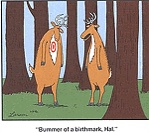What I’ve provided is to provide a summary of our ongoing conversation on Expertise. My goal is to try to put a wapper around this topic by answering the question, “Why is it important for first year students to know about the Continuum of Pedagogical Expertise?” Hope this is helpful.
Month: January 2006
Membering The Program
I was thinking the other day about memory and what it meant to re-member. It’s a little like the day I took the word en-courage apart and its meaning suddenly changed from a word that had a multitude of warm and fuzzy attributes to a word that signified courage. When a teacher encourages children to learn, they create a circumstance that allows a child to take on courage. It is through those acts of personal courage that fundamental learning change happens. After that moment, thinking about the meaning of “en-couragement” with regards to teaching meant far more to me than it ever had before in my professional (and personal) life.
The same shift in perspective is now true with the word “remember.” Cognitively, the complexity of our conceptual structures is rivaled only by the intricacy of their interconnectedness. I never thought I would live to see actual neurological connections. Their photographic reality is now just another google image event. We remember things sometimes in the most roundabout fashion. Everyone knows this. We can’t remember a name, but we do remember the last place we saw the person whose name we are trying to recall. They had a dog – a pug. The pug was in their kitchen during the time the room was filled with the delicious, sweet, cinnamon laced odor of a baking apple pie and zingo! “Hight” – the name of the folks you were trying to recall – turns on in your mind like you are turning the knob of a controlled intensity bedlamp. Going from the pug to the family name traced a path of hard-wired, interconnected neural connections across how many schematic constructions of thought, language, emotion, and sensation; all of it engineered by your own smart decision to consciously direct your recall process just to the left – or right – of the real target. You got to your friend’s name by imagining the Pug in her home. You constructed a virtual cognitive journey that put together again – re-membered – her name from incredibly layered and intimately elaborated cognitive schema. In this cognitive system, two plus two equals about fourteen. The result occurs because the parts coming together is way bigger and more profound than any one of those memories traces taken singly. Once assembled, schematic wiring becomes much more than any one of its neuronic members.
That’s the way it is with my elementary education program. Who we are and what we’ve built over twenty years of almost daily activity has created a program of highly complex, incredibly layered and personally constructed processes of people, places, purposes, and products. Thought rationally arrived at, the structures currently in place – faculty roles, student assignments, mentoring relationships, portfolio entries, program principles, internship classrooms, friendships both personal and professional – are highly elaborated and intertwined and in some ways, arational. Their current reality in many ways take on a life of their own, different from what was created, different and often better. These structures are constructed and tended by groups of people and across time, and are hard wired into our system in complicated ways.
What’s most interesting is that like memory, they do not work by themselves. They have no use by themselves. The program works because the people who created the structures tend to it. When a faculty member creates a structural component for a program in a school, part of that act of creation occurs because of the respect school people have for that person’s knowledge, skills, and yes, values. You don’t mentor students year after year because someone tells you things will work out; you mentor a student because you know – an evidentiary condition – that when things don’t work out, the “program” will be there to sort out the difficulties and make the uncomfortable decisions required by the situation. At their very basic level, programs are nothing more, well, not much more, than the people who make them work. And that’s where the analogy to memory comes in.
When people leave programs, whether by pink slip, retirement, or even by means of one’s good fortune, programs are dismembered. And you cannot re-member them by simply putting the students affected by loss in another class or shifting an experience to a new site or adding a new graduate student to take over the dis-membered functions of the organization. My program is membered. We the members of the faculty who built it, for better or for worse, have membered our program. Pink slips dis-member the program; re-membering it, because of the relational quality of its constructive process, is close to if not impossible, especially when the process of dismembering approaches catastrophic proportions.
So let us be clear here. We are not monitoring changes and adjusting processes, we are dismembering a program which is for all intents and purposes, ending it as it is currently known. If we end up at the close of the day with forty percent fewer faculty and increasing student numbers, we will have undergone a programmatic lobotomy. Our future will bear little connection or relationship to our past. We may well possess virtual memories that will undoubtedly get better over time…they always do. What we will be doing, if anything, will bear little resemblance to what we have accomplished to date.
And that will be cause for deep embarrassment. Embarrassment. Em-barrassment. Hmmm. Now that’s an interesting word… .
Bush Counter
Project on the New Generation of Teachers
Susan Johnson, Director of this project is doing the keynote at NEERO this Spring (April 26-28, Portsmouth, NH). There are a wealth of materials on this website. Although I had not heard of her, other members of the Neero Board were very excited that she accepted our invitation. I haven’t looked through the resources yet but they are broad and span areas of policy, instruction, curriculum, career development, and so on.
Classes Begin
Symbolic Support?
Operating In Chaos
I realize how much my mind operates in sequential patterns AND how important it is to see the wisdom of opportunity in chaos. Multiple dynamics are operative now as department committees, program committees, soon-to-be college committees, union activities and various faculties get involved with the transformation processes now under way. My desire is to contain and plan a strategy that would sequentially bring greater pressure to bear on the decision makers; especially pressure that requires a disposition to know what we do BEFORE action to limit or change or otherwise constrain it takes place.
This is not possible now. It is pure fantasy to think anything as complicated as this multiple front effort can be contained. Wishing it to be otherwise is wasted effort.
Chips will fall where they may. When all is said and done, let us hope the effort has been worth it. Frankly, I have no idea if we are ending old programs or creating new ones in the long run. In the short run, the efforts are definitely being driven by initiatives designed to preserve programs and positions, all focusing of course on saving the jobs of our colleagues. Unless the current process is halted, we have moved beyond that point. Accommodations will not be what was once in place. Whatever happens from this point on will be new territory for us all.
Scenarios…
Introduction:
I’m not sure what box I’m thinking outside of here. But I can’t quite parse the student numbers issue. But I think we should start dreaming programs and let the student numbers issue follow. We need to develop several large courses to attract students from across the university…think three credit diversity requirement of Race and Racism in the US. Think Multicultural Children’s Literature. Think Progressive Thought For Democratic Schools. Think Schooling and Parenting For A Democratic Society.
Scenario One.
Four year program. Students from all programs take foundation, psychology, introduction to education courses together as a group. Team taught across el/md/sec/fdn faculty. School experience through SL connections throughout. Methods stay within programs. Student teaching local, faculty from all programs supervise across programs.
Variation: Primary education goes to echd. Elem works with grades 3-6, blends with middle level ed. All methods taught in one block with pull out discussion sections dealing with program specific adaptations.
Variation: Echd comes into DOE. Teacher education programs under one organizational roof. One teacher education faculty = echd, intermediate, middle, secondary.
Scenario Two.
Fourth year and fifth year program. Foundation, psychology courses taken all together as a group. Faculty team. Summer school (public school) methods experience between 4th and 5th year. Fifth year internships constitute student teaching. BA and MEd. Grant support. Interns pair up, take over classroom teaching slot. Teacher released for graduate work and program supervision/teaching.
Variation: Fifth year internship occurs partially in urban school with need. We (whoever that is – released teachers??) work there. Graduate work 2/3s distance learning + one UVM person in the school.
Scenario Three.
ElEd. Foundations first year. Psychology second year. SL connection with both courses in schools, after school programs, boys and girls clubs, homework sessions at schools. Methods third year modularized, integrated with school SL strands across whole year. Summer school teaching between third and fourth year. Major internship fourth year. Heavy technology involvement throughout. El/Md/Sec/Fdn faculty teach throughout. Grant support.
Scenario Four.
Interprofessional Model. Teams of faculty work with cohorts of students. Team = education generalists, sw faculty member, foundations faculty member. Content modularized as much as possible with ample use of technology. Social work students in schools as well. Each cohort has a faculty leader responsible for overall conduct of content. Grant supported.
Scenario Five.
We do pre-professional prep. in junior and senior years to large numbers of students – if they will come. Between fourth and fifth year, we run several summer school programs to deliver an introductory methods experiences. Fifth year student teaching, interns paired, take over class, teacher released for supervisory and methods teaching responsibilities along with a university faculty person. Ample technology support. BA + MEd. or PBAC. Module/competency based. No “courses” as such.
Scenario Six.
We go to “experts” like Deborah Meier, others + an ongoing focus forum of our students – the really “wired @Generation ones” to really renovate what we do before we do anything!
Other ideas?????
New (recycled) ideas:
Summer school learning. Could be focused on struggling populations.
Cross program course work.
Modularized experiences
Teacher release/graduate work.
Ba/med program for eled.
Release primary prep. to echd.
Teacher ed faculty one faculty, teaching together.
Heavy, focused, planned technology involvement.
Things to keep in mind:
Numbers count.
External money counts.
Flash/early involvement attracts current students. Are we talking about new students?
Technology is the new frontier.
Teach for America model attractive in terms of money and numbers and quality?
Urban Frontier program.
Oakledge 1
I absolutely love this picture. Its at Oakledge, two days ago, about 330pm. It isn’t often that I can get this kind of depth of field and capture what is beneath and above the surface. There is life below, above and on the edge that separates the two.
Gingerbread Cookies
The front is so delicate, so precise. What’s the science of hoarfrost on the edge of these cookies, er… oak leaves?



